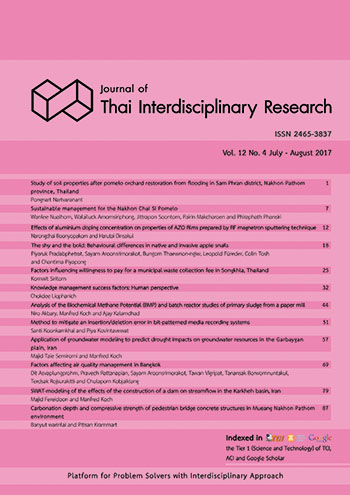Effects of aluminium doping concentration on properties of AZO films prepared by RF magnetron sputtering technique
Main Article Content
Abstract
In this research, the aluminium-doped zinc oxide films were prepared from undoped and 1 – 5 weight percentage (wt.%) of Al2O3 doped ZnO ceramic targets by RF magnetron sputtering technique in order to study the effect of Al doping concentration on the properties of prepared AZO films. The AZO films were deposited on glass slides at room temperature and post-annealed at 500°C in vacuum for 1 hour. Atomic percentage (at.%) of Al compositions, film structures and electrical-optical properties were characterized. It was found that at.% of Al doping concentration were 3.45, 5.77, 6.12, 11.18 and 12.77 in the films deposited from 1 – 5 wt.% Al2O3 doped targets, respectively. Carrier concentration and optical band gap also improved with increasing Al doping concentration. It implied that higher Al doping concentration increased Al substitutions for Zn atoms. However, excess Al doping concentration has no longer contributed to Al substitution but played a role of electron traps resulting in the decrease of carrier concentration and optical band gap. From XRD spectra, it was found that undoped and 3.45 at.% Al-doped ZnO films showed preferred orientation in (002) plane which drastically decreased and disappeared with higher Al doping concentration but, on the other hand, (100) and (101) peaks started to be detected. Therefore, the increase of Al doping resulted in the change of orientation and poor crystallinity. As a result, the Hall mobility decreased because of dominant grain boundary scattering. Minimum resistivity of 2.01 x 10-3 W.cm was achieved for the AZO films with 3.45 at.% Al doping concentration.


